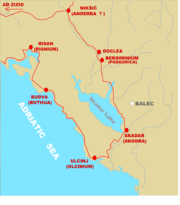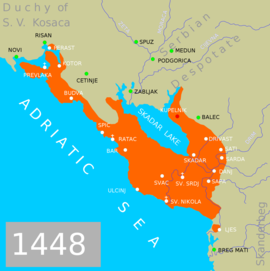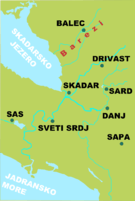Baleč
Baleč (Italian: Balezo,[1] Albanian: Balec[2]) was an Albanian medieval fortified town near Shkodër in what is now Albania. It was built on the hill whose name was Balez.[3] The settlement originated in Roman times. During Byzantine rule over the area, it was part of the Dyrrhachium theme. Later it was a seat of a župa of the Kingdom of Duklja, and later still of the Lordship of Zeta. Baleč suffered much damage during the Second Scutari War between the Serbian Despotate and the Republic of Venice. After the Republic of Venice gained control over it at the beginning of the 15th century, its size was reduced to a small pronoia with only 25 houses, and the fortress was abandoned and fell to ruin. Skanderbeg's forces rebuilt the fortress during his war with Venice in 1448 and established a strong garrison in it, but the Venetian forces soon drove them away and demolished the fortress. Ottoman plans to rebuild Baleč and populate it with Turkish settlers were never implemented and Baleč remained in ruins, which can still be seen today.
Balšići family name
Some authors derive the name of the Balšić noble family (Albanian: Balshajt) from the name of this town. Alternative names for this family include Balesium, Balezza, Balezum, Balezo and Barizi.[4] According to another opinion, the root of the Balšić anthroponym (which emerged in its actual form in 1455) is the name of village Balovc near Podujevo, derived from Balin Potok.[5]
History
Roman Empire

It is thought that Balec comes from Illyrian, and might be connected with the Albanian word "ballë". The first who came to this conclusion was Milan Sufflay.[6] Baleč was built on the site of a former settlement of the Roman period,[6][7] that was destroyed by Avars and Slavs.[6] Its fortress has a Roman origin.[8] Baleč was near the road that led from Shkodër to Duklja and Onogošt (modern day Nikšić),[9] near several important settlements and water resources.[6]
Duklja and Zeta
Baleč was part of Byzantine Dyrrhachium until the Kingdom of Duklja, under Stefan Vojislav (1018–1043), captured it and made it the capital of the župa of Barezi.[10][11] According to the Chronicle of the Priest of Duklja, after the death of Stefan Vojislav in 1044 control over Baleč and the Barezi župa was inherited by his son Mihailo I Vojislavljević.[10]
In the 14th century, control over the region, including Baleč, passed to the Lordship of Zeta, ruled by the Balšić family.
Venetian Republic
At the beginning of the 15th century, the Venetian Republic took control of Baleč, which became a pronoia, whose pronoiarios (the person to whom the pronoia was granted) lay under obligation to recognize the rights of the bishop of the Roman Catholic Diocese of Balecium, if were to return and claim them.[12] Radič Humoj, a member of Humoj family, was appointed by the governor of Scutari as pronoier over Baleč in period 1402—1403, which was confirmed by decision of Venetian Senate on 16 September 1404.[13] Venetian census of 1417 shows that Baleč pronoia was directly subordinated to the governor of Scutari and had 25 houses.[14]
After Radič's death, the Venetian governor of Scutari gave the Baleč pronoia to Radić's brother Andrija (who was then voivoda of the area north of the Shkodër) and his son Kojčin.[15][16] Decision of Scutari's governor was confirmed by Venetian Senate on 13 February 1419.
Rebuilding and destruction of the fortress during Skanderbeg's rebellion

In December 1447 Skanderbeg began his war against Venice and besieged Dagnum. When he realised that his siege was unsuccessful he ordered the rebuilding of the fortress of Baleč, which was unoccupied and in ruins. The main purpose of placing a garrison at Baleč was to cut the supply routes to besieged Dagnum and to gain control over the lands around Shkodër.[17] The 2,000 soldiers of the Baleč garrison were under the command of Skanderbeg's nephew Hamza Kastrioti and Marin Spani, but Kastrioti was ordered to attack Drivast,[8] leaving Spani in sole command.[18] Marin found the newly rebuilt fortress insecure and, when his relative Peter Spani informed him that a large Venetian force was heading there, he immediately retreated with his soldiers to Danj.[19] The Venetian forces retook the fortress, burned the wooden parts and demolished the rebuilt walls.[8][20] Andrija and Kojčin Humoj, together with Simeon Vulkata, led the pro-Venetian alliance against Skanderbeg, fighting particularly fiercely for control over Baleč and Drivast in 1447.[21]
Although the Baleč area was under firm Venetian control since the beginning of the 15th century, Baleč slowly became impoverished and had ceased to exist as a town long before 1448, when the rebuilt fortress was destroyed by the Venetians[22] and the town was already only a memory.[23][24]
Aftermath
At the beginning of 1474 the whole region around Shkodër, including the abandoned Baleč, came under Ottoman rule. According to some sources the Ottoman sultan had intentions to rebuild Podgorica and Baleč in 1474 and to settle them with 5,000 Turkish families in order to establish an additional obstacle for cooperation of Crnojević's Zeta and besieged Venetian Shkodër.[25][26][6] However the plans about Balec were not realized and later Marin Barleti described Balec as ruins.[6]
Religion
- For (Latin) ecclesiastical history see Roman Catholic Diocese of Balecium
There were many Orthodox churches in Baleč and surrounding villages.[27] There are records about an Orthodox monastery in the village Kupinik (Latin: Copenico) almost completely populated by Slavs, which owned a mill on the river Rioli near Baleč.[28] There are ruins of two churches in Baleč with their altars orientated toward East.[29] In 1879 Russian consul Ivan Stepanovič Jastrebov, published his notes about his visit to Shkodër, which also included visit to ruins of Baleč. Jastrebov described the ruins of two Orthodox churches in Baleč, whose ruins belonged to the territory of Rioli tribe. He explained that the first church was a cathedral with dimensions of 25 times 10 steps, and a narthex with dimensions 17 times 10 steps.[30] Jastrebov described another church on the southern side of Baleč as smaller and built in the same stile as cathedral.
At the beginning of the 14th century, Baleč was the seat of a small Catholic diocese.[31] In 1356, Bishop Andreas Citer complained that his bishopric was full of schismatics.[32] The diocese had been laid waste and impoverished by "the schismatics of the kingdom of Rascia", who had completely destroyed the monastery situated 5000 paces from the cathedral. In response, Pope Innocent VI granted him in commendam, on 26 September of the same year, the Benedictine monastery of St. John in Drivast.[33][34] At this time Baleč must have ceased to exist as a town, so that, although bishops continued to be appointed to the see,[35][36] by 1448, when even the fortress rebuilt by Skanderberg was destroyed, the town was no more than a memory.[23] The bishopric of Balecium, no longer a residential see, is today listed by the Catholic Church as a titular see.[37]
References
- Bešić, Zarij M. (1970). Istorija Črne Gore, Volume 2, Part 2 (in Serbian). Titograd: Redakcija za istoriju Črne Gore. Retrieved 17 January 2012.
Итал (Balezo)
- Lala, Etleva (July 5, 2010). "Kur Helena e Francës kujdesej për Manastirin e Shën Sergjit". Albanian American Community Organization "Jeta e Re" New Life. pp. 4–5.
- Srpski etnografski zbornik, Volumes 27-28 (in Serbian). Belgrade: Srpska kraljevska akademija. 1923. p. 14. Retrieved 23 January 2012.
Balez se nalazi na brdu Maja Balezit
- Akademia e Shkencave e RPS të Shqipërisë (1985). The Albanians and their territories. "8 Nëntori" Pub. House. p. 323. Retrieved 22 January 2012.
Whereas JS Jastrebov, when speaking of the Balshaj of Shkodra calls then Balesium, Balezza, Balezum, Balezo and adds that the Greeks in Dukel74 called them Barizi.
- Akademia e Shkencave e RPS të Shqipërisë (1985). The Albanians and their territories. "8 Nëntori" Pub. House. p. 323. Retrieved 22 January 2012.
This anthroponym emerges in a topical form in 1455 and today we find it in the root of the name of the village of Balovc of the region of Pedieva. Hence in the earlier periods this village appears in the form of Balin Potok
- Malaj, Edmond. "Baleci ne Mesjete". Studime Historike. 53 (3–4): 27–48.
- Srpski etnografski zbornik, Volumes 27-28 (in Serbian). Belgrade: Srpska kraljevska akademija. 1923. p. 18. Retrieved 23 January 2012.
Gradovi na ... Balezu su djelo Rimljana.
- Barbarich, Eugenio (1905), Albania (in Italian), Rome: E. Voghera, p. 184, OCLC 23507999,
l'antico castello romano di Ballesio
- Srpski etnografski zbornik, Volumes 27-28 (in Serbian). Belgrade: Srpska kraljevska akademija. 1923. p. 14. Retrieved 23 January 2012.
Поред ових градова водио је стари пут од Скадра за за Диоклеју и даље за Оногошт, а пролазио је поред Балеза,
- Živković, Tibor (2006), Portreti srpskih vladara : IX-XII vek (in Serbian), Belgrade: Zavod za udžbenike i nastavna sredstva, p. 105, ISBN 978-86-17-13754-8, OCLC 153312547, retrieved 23 January 2012,
Među župama koje su pomenute kao sastavni delovi dukljanske države u trenutku smrti Stefana Vojislava, samo jedna nije bila deo Duklje (Zete) u prethodnom spisku župa koji donosi Pop Dukljanin, a koji bi se mogao opredeliti u polovinu X veka. U pitanju je župa Bareci koja je obuhvatala područje istočno od Skadra. Tako bi se moglo reći da je Stefan Vojislav izvršio prilično skromno teritorijalno proširewe svoje zemlje na račun dračkog temata ... Stefan Vojislav je... ostavio udovicu i petoricu sinova...Najstariji sin Gojislav dobio je na upravu.. Mihailo, Oblik (dan. Taraboš), Prapratnu i Crmnicu; Saganek, oblast Gorsku (kraj oko Podgorice), Kupelnik (na istočnoj strani skadarskog blata) i Bareci (dan. Maja Balezit kod Skadra))
- Bogdanović, Dimitrije (1990). Knjiga o Kosovu: razgovori o Kosovu (in Serbian). Književne novine. p. 36. Retrieved 21 January 2012.
У доба највеће проширености дукљанске српске државе под Бодином (1081-1116) њеним границама је била обухваћена читава данашња северна Албанија, ...северно од Дрима, али и пространа облас јужно од Дрима укључујући све мале градове у скадарским жупама (Балеч, Дриваст, Сард, Дањ, Сапа, Шаст, Св. Срђ и Влах)
- Božić 1979, p. 301
... млетачки управници поверили су 1404. године епископски град Балеч једном пронијару под условом да призна права балечког епископа
- Serbian Academy of Science and Arts 1980, p. 43
Радич Хумој потврдио је у звању Еустахијев наследник Донат де Порто (1402—1403) а затим и сам Сенат 16 септембра 1404.
- Božić 1979, p. 275
... Територија потчињена непосредно скадарском кнезу обухватала је 1417 године један град (Балеч са 25 кућа),... "
- Serbian Academy of Science and Arts 1980, p. 49
Радич Хумој је умро пре но што је пописан скадарски крај. Балеч је, после њега, припао његовом брату Андрији, који је био војвода предела изнад Скадра, и сину Којчину.
- Rivista di studi bizantini e neoellenici, Volume 7. Rome: Istituto per l'Europa orientale (Rome, Italy), Associazione nazionale per gli studi bizantini. 1953. p. 506. Retrieved 28 January 2012.
- Serbian Academy of Science and Arts 1980, p. 55
Опсада Дања остала је без видног успеха, па је Скендербег донео одлуку да обнови Балеч, који је већ тада представљао гомилу рушевина. Посада Балеча имала би дужност да спречава снабдевање Дања и да уноси немир по скадарском пољу.
- Serbian Academy of Science and Arts 1980, p. 39
За команданта балечке посаде Скендербег је одредио свог нећака Амесу (Хамзу) и Марина Спана. Али се Амеса тамо није хтео задржавати, већ је кренуо на Дриваст, а Марин се с 2 ООО својих људи осећао угрожен у тек обновљеном граду
- Serbian Academy of Science and Arts 1980, p. 55
... да поруше обновљени Балеч с таквим снагама као да је у питању највећа тврђава. То је Петар Спан јавио свом рођаку Марину и овај је у последњем тренутку сакупио војнике и спустио се према Дању
- Serbian Academy of Science and Arts 1980, p. 39
... Млечани су запалили дрвену грађу а свеже зидове сравнили са земљом
- Schmitt, Oliver Jens (2001), Das venezianische Albanien (1392-1479), München: R. Oldenbourg Verlag GmbH München, ISBN 3-486-56569--9,
In einer getreidearmen Gegend war dies ein Anschlag auf die Lebensgrundlagen der Gemeinde. Venedig ging in dieser Frage äusserst behutsam vor, denn Koja und Andreas Humoj hatten der Signoria bedeutende Dienste geleistet. Zusammen mit Simeon Vulkata waren sie an der Spitze der venezianischen Verbände gegen Skanderbeg ins Feld gezogen (1447). In ihren Machtgebieten um Balezo und Drivasto wurde besonders heftig gekämpft.
- Serbian Academy of Science and Arts 1980, p. 39
За команданта балечке посаде Скендербег је одредио свог нећака Амесу (Хамзу) и Марина Спана. Али се Амеса тамо није хтео задржавати, већ зе кренуо на Дриваст, а Марин се с 2 ООО својих људи осећао угрожен у тек обновљеном граду ... Млечани су запалили дрвену грађу а свеже зидове сравнили са земљом
- .Wissenschaftliche Mitteilungen aus Bosnien und der Hercegowina, Volume 10 (1907), p. 6. Quote: Balesium dürfte als Stadt um die Mitte der 14. Jahrhunderts zu bestehen aufgehört haben, so daß im Jahre 1448 wirklich nichts mehr als die Erinnerung existierte.
- Antonović, Miloš (2003), Town and district in littoral of Zeta and northern Albania in 14th and 15th century (in Serbian), Belgrade: Istorijski institut, p. 236, ISBN 978-86-7743-031-3, OCLC 55953999, retrieved 21 January 2012,
Мада чврсто под млетачком контролом, сиромашни Балеч је на- ставио да пропада, да би 1448. г. сасвим опустео.
- Božić 1979, p. 295
почетком 1474 ... о султановој намери да обнови Подгорицу и да је насели са пет хиљада турских домаћинстава, а исто тако да подигне из рушевина стари град Балеч
- Ćorović, Vladimir (2005). Istorija Srba (in Serbian). Zoograf. p. 357. Retrieved 21 January 2012.
...очвидно из разлога да спрече везе између Зећана и Албанаца
- Antonović, Miloš (2003), Town and district in littoral of Zeta and northern Albania in 14th and 15th century (in Serbian), Belgrade: Istorijski institut, p. 278, ISBN 978-86-7743-031-3, OCLC 55953999, retrieved 21 January 2012,
видео је православне цркве у старој бенедиктанској опатији Св. Јована у Штоју, Балечу и селу Вукли
- Antonović, Miloš (2003), Town and district in littoral of Zeta and northern Albania in 14th and 15th century (in Serbian), Belgrade: Istorijski institut, p. 257, ISBN 978-86-7743-031-3, OCLC 55953999, retrieved 21 January 2012,
Православна црква села Copenico (-Купиник) чији су скоро сви житељи Словени, ван свог атара имала је ... и млин на речици Риолију код Балеча.
- Vukmanović, Jovan, "Etnički i kulturni tragovi Srba u Sjevernoj Albaniji", Stanovništvo slovenskog porijekla u Albaniji : zbornik radova sa međunarodnog naučnog skupa održanog u Cetinju 21, 22. i 23. juna 1990 (in Serbian), Titograd: Istorijski institut SR Crne Gore ; Stručna knj., OCLC 29549273,
U gradu Baleš, danas Baleza, i na drugoj strani Bojane nalaze se u ruševinama dvije crkve, građene sa oltarima prema istoku.
- Folić, Milutin, "Izveštaji ruskog konzula Ivana Stepanoviča Jastrebova iz Skadra o slovenskom življu i njihovim crkvama u Albaniji u drugoj polovini XIX veka", Stanovništvo slovenskog porijekla u Albaniji : zbornik radova sa međunarodnog naučnog skupa održanog u Cetinju 21, 22. i 23. juna 1990 (in Serbian), Titograd: Istorijski institut SR Crne Gore ; Stručna knj., OCLC 29549273,
U gradu Balešu kako opisuje Jastrebov, da je on u riolskom plemenu na severoistoku od Skadra. Grad je na istočnom brdu Balezi. Sada je u razvalinama. U njemu se nalazi razrušena crkva a sada su zidine. Oltar joj je bio okrenut na istok. U dužini od 25 koraka, u širini 10. Ima osobitu pripratu izvan vrata za oglašene, dužine 17 koraka, a širine 10.
- Božić 1979, p. 301
Број ситних епископија које су окупљене око епископије у Бару управо је зачуђујући, множећи се до 14. века оне су основане у .... Балечу...
- Slijepčević, Đoko M. (1983). Srpsko-arbanaški odnosi kroz vekove sa posebnim osvrtom na novije vreme (in Serbian). Himelstir. p. 61. Retrieved 7 July 2011.
У Балезу, код Коплика, био је бискуп и овај се 1356. године жали архиепископу барскоме, да је његова бискупија пуна шизматика
- Antonović, Miloš (2003), Town and district in littoral of Zeta and northern Albania in 14th and 15th century (in Serbian), Belgrade: Istorijski institut, p. 57, ISBN 978-86-7743-031-3, OCLC 55953999, retrieved 21 January 2012,
Инокентије VI је 26. септембра 1356. г. дао балечком епископу Андрији у коменду бенедиктански манастир Св. Јована у Дривасту. Као разлог за овај неуобичајен потез, јер Дриваст има свог епископа, наведено је да је манастир после смрти опата Андрије "растурен" од тамошњих шизматика, као и сама балечка дијецеза.
- .Wissenschaftliche Mitteilungen aus Bosnien und der Hercegowina, Volume 10 (1907), p. 6. Quote: ... welches Kloster als "ab regni Rasciae schismaticis quasi totaliter dissipatum" bezeichnet wird; die Verleihung dieser Pfründe erfolgte, weil die Diözese von Balecium von den Schismatikern verwüstet worden und verarmt war. Das Kloster, welches als von der Kirche von Balesium 5000 Schritte entfernt bezeichnet wird ...
- Pius Bonifacius Gams, Series episcoporum Ecclesiae Catholicae, Leipzig 1931, pp. 395-396
- Konrad Eubel, Hierarchia Catholica Medii Aevi, vol. 1, pp. 125-126; vol. 2, p. 101
- Annuario Pontificio 2013 (Libreria Editrice Vaticana 2013 ISBN 978-88-209-9070-1), p. 845
Sources
- Božić, Ivan (1979). Nemirno pomorje XV veka (in Serbian). Beograd: Srpska književna zadruga. OCLC 5845972.CS1 maint: ref=harv (link)
- Serbian Academy of Science and Arts (1980). Glas (in Serbian). 319-323. Belgrade: Serbian Academy of Science and Arts. Retrieved 20 January 2012.CS1 maint: ref=harv (link)
Further reading
- Ippen, Theodor (1900), "Stari spomenici u Albaniji", Glasnik Zemaljskog muzeja u Bosni i Hercegovini, Zbirka povjesti, 12, Sarajevo, Austria-Hungary: Zemaljska štamparija, pp. 511–531
